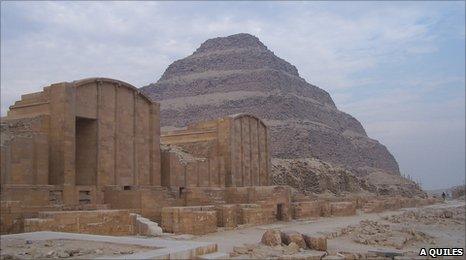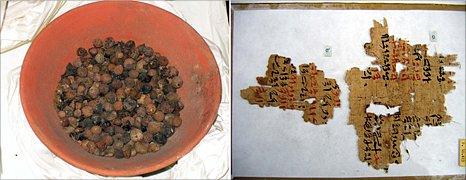Radiocarbon dating verifies ancient Egypt's history
- Published

The Step Pyramid of Djoser in Saqqara is the oldest stone pyramid in Egypt
Experts have used scientific dating techniques to verify the historical chronology of ancient Egypt.
Radiocarbon dating was used to show that the chronology of Egypt's Old, Middle and New Kingdoms is indeed accurate.
The researchers dated seeds found in pharaohs' tombs, including some from the tomb of the King Tutankhamun.
They write in the journal Science that some of the samples are more than 4,500 years old.
Radiocarbon dating of ancient Egyptian objects is nothing new.
But this time, the scientists say, they were able to use a very precise statistical technique to actually verify the Egyptian history.
"The very first dating done with radiocarbon was dating Egyptian material of known dates, to check that [the method] worked," said Andrew Shortland from Cranfield University in the UK.
"Now, for the very first time, [we] managed to get radiocarbon techniques so good, that we can do it completely the opposite way around. We can say, from using radiocarbon, whether the Egyptian history is correct or not.
"Previously radiocarbon hasn't had a voice on this because the errors had been so great. Now radiocarbon is able to distinguish between different ideas of reconstructing the history."
The study brought together researchers from the UK, France, Austria and Israel.

Scientists used Oxford's radiocarbon accelerator to date the items
They dated 211 various plants, seeds and papyrus samples, obtained from museum collections.
"The museums were all very helpful in providing material we were interested in—especially important since export of samples from Egypt is currently prohibited," said Christopher Ramsey, the lead author of the study, from the school of archaeology at the University of Oxford.
"Fortunately, we only needed samples that were about the same size as a grain of wheat," he added.
Thomas Higham, another member of the team who is also from the University of Oxford, explained that many items were found in ancient Egyptians' tombs and other archeological sites "where we could independently determine their historical age".
King Tut's tomb
"For example, we used seeds and plant material from Tutankhamun's tomb, which is very precisely dated. We also used seeds from a room underneath the Saqqara step pyramid dated to a specific year of the reign of King Djoser," he said.
Djoser was one of the pharaohs of the third dynasty of the Old Kingdom.
The step pyramid of Djoser in Saqqara is believed to be the oldest stone pyramid in Egypt.
Dr Ramsey's team was able to determine the exact period when this king reigned Egypt - from about 2691 to roughly 2625 BC, said the scientist.
The team found that this particular event took place earlier than some scholars previously thought.
"For the first time, radiocarbon dating has become precise enough to constrain the history of ancient Egypt to very specific dates," said Dr Ramsey.
"I think scholars and scientists will be glad to hear that our small team of researchers has independently corroborated a century of scholarship in just three years."

Some of the items, among them seeds and papyrus, were more than 4,000 years old
- Published31 May 2010